

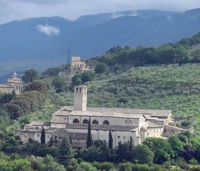
This church is dedicated to St Pontian, who was martyred in the reign of the Emperor Antoninus Pius (138-61) and buried outside Spoleto, "in loco qui appellatur Lucianus". This is almost certainly the hill that is now called Colle Ciciano, the site of the present church.
SS Carpophorus and Abundius, who were martyred in the 4th century, were buried by a pious matron called Sincleta "in cimiterio Pontiani, non longe ab urbe Spoletana". This indicates that a cemetery had been established near the grave of St Pontian from an early date. Three early sarcophagi that were found in this cemetery are now in the crypt (see below). The legend of St John of Spoleto, which was probably written at the time of the Emperor Otto II (973-83), refers to the “cenobio del beatissimo Ponziano” and the adjacent cemetery that housed the relics of martyrs.
The relics of St Pontian were preserved in an oratory in the cemetery that seems to have been the site of a Benedictine monastery (cenobium beatissimi martyris Pontiani) by the 10th century. In 966 Bishop Balderik (who was in Italy for the coronation of the Emperor Otto I) took most of the relics of St Pontian for the cathedral of St Martin, which he had built in Utrecht.
San Ponziano subsequently passed to community of Benedictine nuns, perhaps at the time that current church was built. This community accumulated a number of possessions: for example, it is documented as in dispute with Bishop Benedetto in 1199 over the ownership of Sant’ Apollinare.
Pope Innocent IV granted a privilege in 1250, at which time the nuns followed the Benedictine Rule. In 1290, Pope Nicholas IV placed the nuns under papal protection. In 1301, Cardinal Napoleone Orsini granted indulgences for those visitingthe church on specified feats days.
Nuns from other communities moved here in the 14th century when their respective nunneries closed:
-
✴those of Santa Maria della Misercordia “prope Spoleto”, in 1353.
-
✴those of Santa Maria Maddalena “di Capatis”, in 1389.
-
✴those of San Paolo, Montefalco, in 1405.
-
✴those of Santa Caterina de Collefloreto, in 1412.
Pope Leo X moved a community of Poor Clares from Santa Maria di Monteluce, Perugia to San Ponziano in 1521 and entrusted their spiritual care to the Observant Franciscans of San Paolo inter Vineas.
San Ponziano must have benefited in 1703 when the St Pontian was credited with saving Spoleto from the earthquake that ravaged much of the surrounding area. He apparently saved the city from earthquakes again in 1767 and in 1785.
-
✴The Commune established a new altar dedicated to St Pontian in the Duomo in 1785, at the start of its re-modelling by Giuseppe Valadier.
-
✴This young architect also designed the new interior of San Ponziano in 1788.
The church and nunnery were suppressed in 1810, when most of its movable works of art were dispersed. The nuns subsequently managed to return but the complex was suppressed again in 1860 and the buildings were sold off for private use.
A community of female Lateran canons that had moved from Santa Maria della Stella to the Monastero della Passione in Via Vaita de Domo (see Walk II) in 1798 moved here in 1903. They observe strict enclosure, although they also offer rooms in the nunnery to tourists in the Casa d’ Accoglienza di S. Ponziano.
Exterior
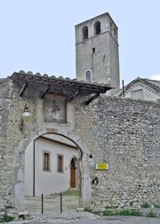
The church, which seems to have been built or rebuilt in the 12th century, stands in an enclosed courtyard.
St Pontian (18th century)
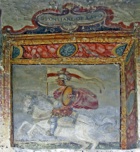
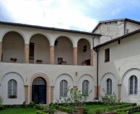
Facade
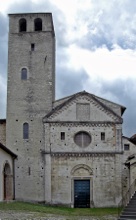
The façade is now in three orders separated by two cornices:
-
✴the bottom order and the central part of the middle order are largely original; but
-
✴the sides of the middle order and the tympanum above were probably later additions.
The lower part of the campanile, to the height of the second cornice, is also probably original.
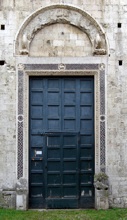
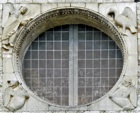
Interior
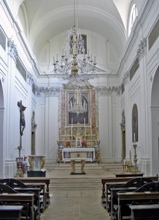
In 1521, when the Poor Clares of Santa Maria di Monteluce, Perugia acquired the complex, they built a wall across the church to separate their choir from the space used for public services. (A similar wall had been built at the church in Perugia in 1449). The choir is not open to visitors but is illustrated in the site of the Casa d' Accoglienza.
As noted above, Giuseppe Valadier re-modelled the interior of the rest of the church in 1788.
Martyrdom of St Pontian (18th century)
This altarpiece by Francesco Appiani is on the high altar. It depicts the decapitation of St Pontian at Ponte Sanguinario (see Walk II).
Reliquary of the sacra testa (1805)
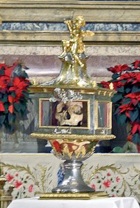
The "recent" history of the relic begins in 1703 when the cult of St Pontian was revived after he was credited with having saved the city from the earthquake that devastated much of the surrounding area. Bishop Pietro Gaddi prayed before what was then an undocumented relic in the crypt of San Ponziano. In 1745, Bishop Paolo Bonavisa initiated an inquiry into the authenticity of this relic. The process took some ten years but the relic's authenticity was finally established in 1755. In 1805, Pope Pius VII formally reconfirmed its authenticity and it was then enclosed in a new silver reliquary.
Reliquary urn (18th century)

Altarpiece (1778)
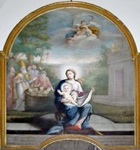
Sarcophagus (ca 600 AD)
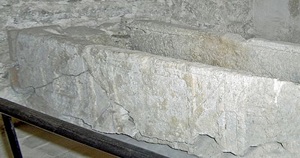
Steps on the left at the end of the left aisle lead down to the crypt, past two sarcophagi that were brought here from the garden of the nunnery. The one illustrated here belongs to a group that seems to have been manufactured in Spoleto in the 5th century, two of which (at Narni and Giano dell’ Umbria) housed the relics of bishop saints (respectively St Juvenal and St Felix). The sarcophagi in this group are characterised by a low relief on one side that consists of a rectangle flanked by two triangles and then by two arches with architraves. A wide variety of dates has been proposed for this group of sarcophagi: that suggested here was suggested by Mario Sensi (referenced below, at p. 90):
-
“The sarcophagus at Foligno which was contemporary with those from Giano, Narni and Spoleto, is assignable on the basis of [the shared] decorative motif to the 6th or 7th century” (my translation).
Crypt
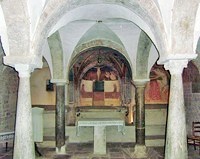
Fortunately, the crypt escaped the re-modelling that transformed the church. It is in the form of a wide nave with two aisles:
-
✴The four columns in the nave have been re-used from an earlier building. The column on the right nearest the altar is actually inverted.
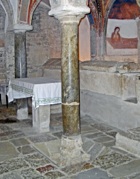
-
✴The nave terminates in an apse that contains three semi-circular chapels. Three sarcophagi that probably came from the early Christian cemetery here are arranged in a line behind the altar, one in front of each of the chapels in the apse.
-
✴Each aisle culminates in a semi-circular apsidal chapel.
Left Apsidal Chapel
SS Bernardino of Siena and Pontian (1481)
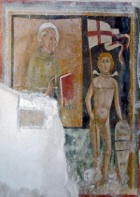
Frescoes on the altar wall (15th century)
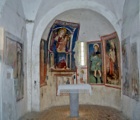
-
✴St Sebastian;
-
✴the Madonna and Child enthroned;
-
✴St Roch; and
-
✴the Madonna and Child enthroned (again).
Frescoes on the Right Wall
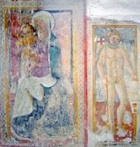
-
✴the Madonna and Child enthroned (1468), which is dated by inscription; and
-
✴St Pontian (15th century), which has the same iconography as the fresco of St Pontian opposite.
Central Apses
Crucifixion (15th century)
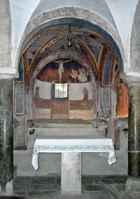
Trinity (ca. 1400)
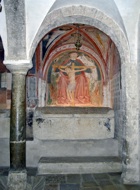
Right Apsidal Chapel
St Michael (14th century)
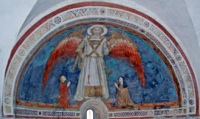
This fresco in the lunette, which is attributed to the Maestro di Fossa, depicts the standing St Michael holding a sword and scales. A man dressed in red kneels to the left and a nun kneels to the right.
Other Frescoes
Madonna and Child (1437)

Madonna and Child (15th century)
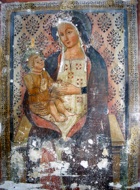
Art from the Church
St Pontian (14th century)
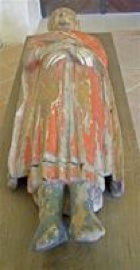
Read more:
M. Sensi, “Le Cattedrali di Foligno”, in
G. Benazzi (Ed.), “Foligno A.d. 1201: La Facciata della Cattedrale di San Feliciano”, (1994) Foligno, pp 88-111
Return to Nunneries on Colle Ciciano.
Return to Monuments of Spoleto.
Return to Walk III (for Santa Maria della Stella) or Walk IV.

